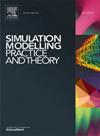Prediction of casted muck pile profiles using discrete element modeling and the Monte Carlo approach
IF 3.5
2区 计算机科学
Q2 COMPUTER SCIENCE, INTERDISCIPLINARY APPLICATIONS
引用次数: 0
Abstract
In applicable orebodies, well-designed cast blasting has proven to be a more efficient method of material transportation than traditional options. Cast blast design has historically been based upon the modification of previous field observations. More recently, numerical models have been developed to predict blasting effects such as vibration and sound, among many. The Discrete Element Modeling method, which creates a large quantity of individual particles, has experienced successful application in modeling blasted rock movement. This work examined several potential improvements to the prediction of muck pile profiles and evaluated their effect based on measured results. Model element shapes, sizes, and distributions were found to have little effect on predictive ability. A stochastic approach was taken to simplify the effect of several pre-blast variables into only initial velocity, which proved to be a valid assumption. A modest central portion of the bench was found to represent the entire bench accurately. Several factors were found to have a high impact on final muck pile profiles, including friction, pit floor variation, and timing. The results illuminate the effects of several parameters crucial to increasing the ability of operators to optimize cast blasts.
用离散元模型和蒙特卡罗方法预测浇注渣土桩的轮廓
在适用的矿体中,设计合理的抛丸爆破被证明是一种比传统方法更有效的材料输送方法。抛丸设计历来是基于对以前现场观测的修正。最近,数值模型已经发展到预测爆破的影响,如振动和声音,在许多。离散元建模方法可以产生大量的单个颗粒,在模拟爆破岩石运动中得到了成功的应用。这项工作研究了几种潜在的改进,以预测渣土桩的轮廓,并评估其效果基于测量结果。模型元素的形状、大小和分布对预测能力的影响很小。采用随机方法将几个爆炸前变量的影响简化为只有初速度的影响,证明了这是一个有效的假设。长凳的中间部分被发现准确地代表了整个长凳。有几个因素对最终的渣土桩轮廓有很大的影响,包括摩擦、坑底变化和时间。结果阐明了几个关键参数对提高操作人员优化铸爆能力的影响。
本文章由计算机程序翻译,如有差异,请以英文原文为准。
求助全文
约1分钟内获得全文
求助全文
来源期刊

Simulation Modelling Practice and Theory
工程技术-计算机:跨学科应用
CiteScore
9.80
自引率
4.80%
发文量
142
审稿时长
21 days
期刊介绍:
The journal Simulation Modelling Practice and Theory provides a forum for original, high-quality papers dealing with any aspect of systems simulation and modelling.
The journal aims at being a reference and a powerful tool to all those professionally active and/or interested in the methods and applications of simulation. Submitted papers will be peer reviewed and must significantly contribute to modelling and simulation in general or use modelling and simulation in application areas.
Paper submission is solicited on:
• theoretical aspects of modelling and simulation including formal modelling, model-checking, random number generators, sensitivity analysis, variance reduction techniques, experimental design, meta-modelling, methods and algorithms for validation and verification, selection and comparison procedures etc.;
• methodology and application of modelling and simulation in any area, including computer systems, networks, real-time and embedded systems, mobile and intelligent agents, manufacturing and transportation systems, management, engineering, biomedical engineering, economics, ecology and environment, education, transaction handling, etc.;
• simulation languages and environments including those, specific to distributed computing, grid computing, high performance computers or computer networks, etc.;
• distributed and real-time simulation, simulation interoperability;
• tools for high performance computing simulation, including dedicated architectures and parallel computing.
 求助内容:
求助内容: 应助结果提醒方式:
应助结果提醒方式:


